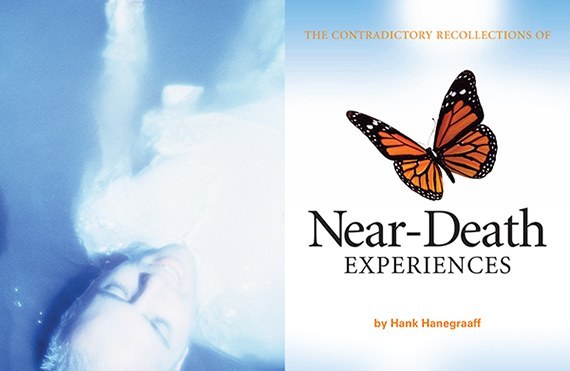This article first appeared in the CHRISTIAN RESEARCH JOURNAL, volume 36, number 02 (2013). The full text of this article in PDF format can be obtained by clicking here. For further information or to subscribe to the CHRISTIAN RESEARCH JOURNAL go to: http://www.equip.org/christian-research-journal/
In the 1975 multimillion bestseller Life after Life, Raymond Moody, widely considered to be the father of Near-Death Experiences, provides a poignant portrayal of unconditional love and universal acceptance emanating from the frontier between this world and the next. Gone are portrayals of reward and punishment in the hereafter, replaced by transcendental experiences so enlivening that returning to the body is tantamount to death by comparison.1
In 1992 Betty Eadie’s popular Embraced by the Light cracked open the divide between death and the afterlife for millions more. Beyond death’s door she experienced a divine light more brilliant than the sun. She recognized the light as the very Jesus she had known in preexistence long before she experienced life on earth. As her light merged with the divine she felt an utter explosion of love and enlightenment. It was there she discovered that Eve had not fallen to temptation but had made a conscious decision to bring about the conditions necessary for progression to godhood.2
In 2004 Baptist pastor Don Piper added to the ever-growing corpus of information on life after life after his own resurrection from the dead. “Now,” writes Pastor Piper in his 90 Minutes in Heaven, “I can speak authoritatively about heaven from firsthand knowledge.”3 Among Piper’s firsthand discoveries were that the streets of heaven were really gold4 and that those who walked them were “old and young and every age in-between.”5 In fact, says Piper, “All of the people I encountered were the same age they had been last time I had seen them.”6 His grandfather still had the same “shock of white hair” and “big banana nose.”7 Most notably, as Piper revealed to a worldwide Christian television audience, because he has already died—and people only die once—Jesus will return within his very own lifetime.8
In 2006 Bill Wiese became a New York Times best-selling author with the release of 23 Minutes in Hell. Unlike the apostle Paul—who did not know whether he was in the body or apart from the body (2 Cor. 12:1–6)—God revealed to Bill that his twenty-three-minute trip involved a bona fide out-of-body experience. In hell, Wiese uncovered a wealth of extrabiblical information, including temperature (300 degrees/zero humidity); the location (center of the earth); reptilian-looking demons (some of whom are fifteen feet tall) who rule over and torture humans; rats the size of dogs; and snakes as big as trains.9
Newer revelations concerning life after life arrived in 2010 with the publication of Heaven Is for Real: A Little Boy’s Astounding Story of His Trip to Heaven and Back. In this multimillion publishing phenomenon—which stayed at no. 1 on the New York Times Best Seller List an astonishing forty-four consecutive weeks—Wesleyan pastor Todd Burpo tells the story of how his son Colton endured the equivalent of a near-death experience. Speaking “with the simple conviction of an eyewitness,” Colton reveals a God who looks like Gabriel, only larger, has blue eyes, yellow hair, and huge wings; a Jesus with sea-green-bluish eyes, brown hair, no wings, but with a rainbow-colored horse; and a Holy Spirit who is bluish but hard to see.10 In addition to interacting with the triune God during his three minutes in heaven, the three-year-old was afforded an opportunity to meet a host of biblical luminaries including John the Baptist, Samson, David, Peter, John the son of Zebedee, and the archangel Gabriel.11 Not only did he meet these Bible heroes, but as a direct “eyewitness” of heaven Colton was empowered to settle theological issues the church has struggled with throughout its history, received revelation superseding that of biblical prophets and apostles, and “had also been shown the future.”12
The quintessential near-death experience, however, did not surface until the 2012 mega-best-selling publication of Proof of Heaven: A Neurosurgeon’s Journey into the Afterlife. “As arrogant as that might sound,” writes Dr. Eben Alexander, “I was allowed to die harder, and travel deeper, than almost all NDE subjects before me.” Indeed, says Dr. Alexander, “mine was in some ways a perfect storm of near- death experiences…a technically near-impeccable near-death experience, perhaps one of the most convincing such cases in modern history.” And through it he finally “understood what religion was really all about”: “You are loved and cherished, dearly, forever.” “You have nothing to fear.” “There is nothing you can do wrong.” “This,” writes Alexander, “is not only the single most important emotional truth in the universe, but also the single most important scientific truth as well.”13
The implications, of course, are profound. No matter what people do in this life, the single greatest truth is that unconditional love and joy awaits them in the life to come. Such is no doubt solace for the impenitent. After murdering his mother, twenty children, and six adults in the Sandy Hook Elementary School massacre in Connecticut, Adam Lanza murders himself and simply soars off on what Alexander romanticizes as “the wing of a butterfly.”14
Moreover, the “unconditionally loving God” he encountered during his near-death experience enabled Alexander to understand he was “part of the Divine.” Remarkably, by way of the Orb (Alexander’s personal guide and interpreter), “Om” (God) revealed mysteries that lie far beyond the reach of modern-day science and learning. “Through the Orb, Om told me that there is not one universe but many—in fact, more than I could conceive.” Not only so, but as revealed by Om, “the universe has no beginning or end.”15
In short, while subscribing to the reality that there is life after life, books such as Alexander’s Proof of Heaven and Burpo’s Heaven Is for Real paint entirely different and conflicting portraits of the afterlife. For Burpo, Jesus and his rainbow-colored pony are central. For Alexander, it is Om and the Orb. Indeed, had Alexander not discovered that the Orb was his birth sister Betsy, he may well have doubted the authenticity of “the whole new worldview” he was slowly building “and thus of the true existence of that entire realm.”16
Time and space permitting, many more revelations from beyond death’s door could be cited. For example, long before Bill Wiese had his hellish out- of-body experience, Jesus personally directed Mary K. Baxter on a forty-day tour of hell. In her bestseller titled A Divine Revelation of Hell, she tells of a place deep within the earth, shaped like a human being, where snakes and rats dwell, and where worms slither through ignited corpses.17 And subsequent to three-year-old Colton Burpo’s return from heaven, six-year-old Alex Malarkey traveled there as well. In the gripping New York Times bestseller titled The Boy Who Came Back from Heaven: A Remarkable Account of Miracles, Angels, and Life Beyond This World, Alex and his father, Kevin, tell “a true story” of “Alex’s direct experience with angels, demons, and, yes, the devil himself.”18 Along the way he encountered “one hundred and fifty pure, white angels with fantastic wings,”19 green demons with long fingernails and hair made of fire, and an earless devil, replete with three heads, a nasty nose, and moldy teeth. Like Colton, Alex was permitted to see God. But in sharp distinction, he was not permitted to see God’s face. Says Alex, “I was in the presence of God. He had a body that was like a human body, but it was a lot bigger. I could only see up to His neck because, like the Bible says, nobody is allowed to see God’s face or that person will die.”20
DISCERNMENT REQUIRED
And therein lies the dilemma. The subjective recollections of those who experience heaven via NDEs are wildly divergent and mutually contradictory—and seemingly informed by their preconceptions. Raymond Moody’s fixation on an eternity devoid of judgment is compatible with his occult predilections. Betty Eadie’s recognition of Jesus from life in the preexistence is consistent with her Mormon beliefs and background. Don Piper’s claim that Jesus will return within his own lifetime harmonizes well with his endtime presuppositions. Bill Wiese’s notion of reptilian-looking demons commissioned to torture humans as the caretakers of hell is consistent with medieval folklore and superstition. The Burpos’ extrabiblical revelations comport well with modern-day prophets who routinely foretell the future. Eben Alexander’s flights with “the Girl on the Butterfly Wing”21 align with his evolutionary preconceptions and his marginalization of sin and the need for the Savior. And, of course, the Malarkeys’ description of the Father with a humanlike body and a devil with three heads fits well with modern sensibilities respecting the ontology of God and angels.
Furthermore, there is the ever-lurking danger of hyper-literalism. Those reporting firsthand observations of heaven and hell are often predisposed to interpret the Bible literalistically. Therefore, it is not surprising that they return from the afterlife with stories of gates made of genuine pearl and streets manufactured from the purest of gold. And such stories are not without precedent. Popular books on heaven are replete with similar statements. It is not uncommon to see heaven described as a translucent cube measuring fifteen hundred miles in each direction (Rev. 21:15–16).22 While the authors may genuinely suppose their interpretations to be in harmony with Scripture, they appear to be at odds with the art and science of biblical interpretation—not to mention plain old common sense. The imagery of the Book of Revelation is not intended to tell us what heaven looks like but rather is intended to tell us what heaven is like.
When John describes Jesus as a lion and a lamb he is using imagery with which even casual readers of Scripture are intimately acquainted. This is likewise so with the imagery of gold, precious stones, and pearls. Their luminous beauty is repugnant when associated with the extreme wickedness of a harlot city “glittering with gold, precious stones and pearls” (Rev. 18:1623) yet resplendent when associated with the extravagant wisdom and wealth of the Holy City coming down out of heaven from God (Rev. 21)—the harlot city an obvious parody of the Holy City. Such is likewise the case when it comes to heaven’s description as a cube. Its measurement is not only parodied by the length and width of mystery Babylon (the ancient Roman Empire) but as with the cube shape of the Holy of Holies in which Jehovah dwelled, Jerusalem, imagined as a cube, will forever be the dwelling place of God. Says John, “Now the dwelling of God is with men, and he will live with them. They will be his people and God himself will be with them and be their God” (Rev. 21:3).
Finally, there is the very real issue of apostolic authority. God himself set the conditions by which new revelations must be ratified—namely, confirmation by those who were eyewitnesses to the resurrection of Jesus Christ. Thus with the death of the apostles there can be no new revelations—much less new revelations that compromise, confuse, or outright contradict “the faith once for all delivered to the saints” (Jude 3). Paul is the quintessential test case. The apostolic community validated him as an eyewitness to the resurrection and as an apostle. Thus, revelation received through the apostle Paul—unlike revelations received through modern revelators—may be deemed reliable and binding on the body of Christ.
Let me be clear. I do not doubt that those mentioned above had actual subjective experiences. But that is precisely the point. Subjective experiences are notoriously unreliable; thus, they must always be tested in light of an objective frame of reference—which in Christianity is the Bible. Colton Burpo may genuinely believe that God has yellow hair and big wings. But we do well to “test everything. Hold on to the good” (1 Thess. 5:21).24
Hank Hanegraaff is president of the Christian Research Institute and host of the Bible Answer Man broadcast heard daily throughout the United States and Canada via radio, satellite radio Sirius-XM 131, and the Internet at Equip.org. For a list of stations airing the Bible Answer Man, or to listen online, log on to equip.org. Hank is the author of many books including the recently released AfterLife: What You Need to Know about Heaven, the Hereafter, and Near-Death Experiences (Worthy Publishing, 2013).
NOTES
- Raymond Moody Jr., Life after Life (Covington, GA: Mockingbird, 1975).
- Betty J. Eadie with Curtis Taylor, Embraced by the Light (Placerville, CA: Gold Leaf Press, 1992).
- Don Piper with Cecil Murphey, 90 Minutes in Heaven: A True Story of Death and Life (Grand Rapids: Revell, 2004), 129.
- Ibid., 34–35.
- Ibid., 24.
- Ibid., 27.
- Ibid., 22.
- “Don Piper tells his experience of Going to Heaven and Coming Back!!” 700 Club, CBN, http://www.youtube.com/watch?v=wx6FBUD_Amc (approximately 8:35 mark).
- Bill Wiese, “23 Minutes in Hell—Bill Wiese Hell Testimony (Extended Hell Version),” http://www.youtube.com/watch?v=nmrTfyM-hbY (see at approximately 23 minutes, accessed December 7, 2012). Though Wiese says his senses were very keen during his twenty-three-minute experience so that he precisely knew such details as the three- hundred-degree temperature and four-thousand-mile distance from the surface to hell’s location at the center of the earth, his story evolves, for on other occasions he says he does not know what the temperature was (see “23 Minutes in Hell – Bill Wiese [Newest Version – Dec 2006] More Details,” http://www.youtube.com/watch?v=ysqXNRdZ4V8 [see at approximately 2.5 minutes, accessed December 7, 2012]).
- See“SpecialGuestsToddandColtonBurpo—Part2,” http://www.youtube.com/watch?v=4pgMOS8Q8nk&feature=related, viewed March 22, 2012.
- Ibid.
- Todd Burpo with Lynn Vincent, Heaven Is for Real: A Little Boy’s Astounding Story of His Trip to Heaven and Back (Nashville: Thomas Nelson, 2010), 136. Concerning the theological question of whether or not infants go to heaven when they die, for example, Burpo writes, “We had wanted to believe that our unborn child had gone to heaven. Even though the Bible is largely silent on this point, we had accepted it by faith. But now, we had an eyewitness [in Colton]: a daughter we had never met was waiting eagerly for us in eternity” (97). Colton seems also to have settled for Burpo the right interpretation of Revelation 9:6–10: the images presented in this passage are not mere symbols for kingdoms or military machinery; rather, they are actual monsters whom Burpo himself will fight with either sword or bow and arrow (Colton can’t recall which) in the battle of Armageddon (135–39).
- Eben Alexander, MD, Proof of Heaven: A Neurosurgeon’s Journey into the Afterlife (New York: Simon and Schuster, 2012), 9, 41, 71, 78, 135, 148, emphasis in original.
- Ibid.,163.
- Ibid.,47, 48, 76, 156.
- Ibid.,164.
- Mary K. Baxter, A Divine Revelation of Hell (Springdale, PA: Whitaker House, 1993).
- Kevin and Alex Malarkey, The Boy Who Came Back from Heaven: A Remarkable Account of Miracles, Angels, and Life beyond This World (Carol Stream, IL: Tyndale, 20









